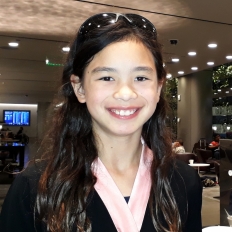Waikoloa Girl Scout Advocates for ‘International Day of Girls’

Kana Walsh is a passionate advocate of children’s rights. When she grows up, she aspires to a career in architecture. PC: USCpublicdiplomacy.org.
A Hawai‘i Island Girl Scout is urging local awareness of the International Day of Girls celebrated every year on Oct. 11 to advocate for girls’ issues and rights around the world.
Kana Walsh of the Girl Scouts of Hawai‘i Troop 806 based in Waikoloa published her first article online with the Center on Public Diplomacy at the University of Southern California to highlight the importance of the occasion.
International Day of Girls was established by the United Nations in 2012 to support more opportunities for young women and increase awareness of gender inequality issues worldwide including: access to education, nutrition, legal rights, medical care and protection from discrimination, violence and forced marriage.
In her article (which follows below), Walsh advocates for programs that will encourage young women in STEM and related fields— specifically humanitarian mapping—especially for girls of her own age group.
Let Girls Map on International Day of the Girl Child
By: Kana Walsh
On October 11, the world will celebrate the International Day of the Girl Child. This year, the focus is on preparing girls to enter a world of work that is being transformed by innovation and automation. By engaging organizations and groups around the world, the United Nations is bringing people together to address this global issue. This involves encouraging them to expand existing learning opportunities, chart new pathways and call on others in the global community to rethink how to prepare girls for a successful transition into the world of work.
I believe one way we can work together to prepare girls for the world of work is to promote Science, Technology, Engineering and Math (STEM). As pointed out by Gwendoline Tilghman, the gender gap in STEM starts in school. When girls are not introduced to STEM technologies early in life, they are far less likely to pursue STEM degrees. Furthermore, girls are far less likely to study STEM subjects when their friends are not studying those subjects. We therefore need programs to introduce groups of girls to STEM subjects. This includes humanitarian mapping.
Open-source, collaborative mapping projects allow users to contribute geospatial data to help visualize locations around the world. This information can be used to tackle humanitarian challenges by identifying where help is needed most. If we want to prepare girls for a successful transition into the world of humanitarian mapping, then it is clear that we need to get more girls mapping at a younger age. And that isn’t going to be easy. Right now, there are a lot of barriers that make it difficult for girls to learn how to use humanitarian mapping tools.
On the International Day of the Girl Child, I believe that countries should promote programs that introduce groups of girls to humanitarian mapping. Unfortunately, there are no programs specifically designed to get kids into humanitarian mapping, and there are no humanitarian mapping platforms that are specifically designed for kids. Furthermore, age restrictions limit kids from being able to use humanitarian mapping programs, and there are no learning materials specifically designed to help kids understand them. It is also very difficult for kids to participate in humanitarian “mapathons.”
Take Youth Mappers, for example. They have created a campaign called “Let Girls Map,” which supports the inclusion of girls and women in mapping communities. It also encourages the celebration of achievements of women student mappers. Let Girls Map is a great way to get girls and women involved in humanitarian mapping. But the problem is that it is specifically designed for young women in college—not for children my age.
Recently, I completed my Bronze Award on coastal flooding for Girl Scouts of the United States. While researching my project, my dad introduced me to Missing Maps. After using this humanitarian mapping platform, I realized that it would be fun and educational for girls my age to learn how to use humanitarian mapping platforms. I really enjoyed being able to visually go to places halfway around the world and see how mappers can help people affected by coastal flooding. However, I also realized that these platforms are not designed for kids to use. That needs to change. Girls my age should be able to map too.
On the International Day of the Girl Child, I believe that countries should promote programs that introduce groups of girls to humanitarian mapping. In the words of Gwendoline Tilghman, these programs would not only increase STEM education for girls. They would also present an opportunity to strengthen economies for future generations. This makes them a smart, sustainable investment that will promote prosperity, gender equality and disaster preparedness.
Kana Walsh is a Girl Scout in Troop 806 of the Girl Scouts of Hawai‘i. She recently completed her Bronze Award on Coastal Flooding in East Africa. She would like to thank her father, Lisa Rau and Nikki Burnett for their editorial support on this article. She would also like to thank Rachel Levine, Shari Chang, Charelle Silva, Kim Morris, Marci Goldman-Manker, the American Red Cross and the Girl Scouts of Hawai‘i for their support of her Bronze Award Project.
Sponsored Content
Comments








